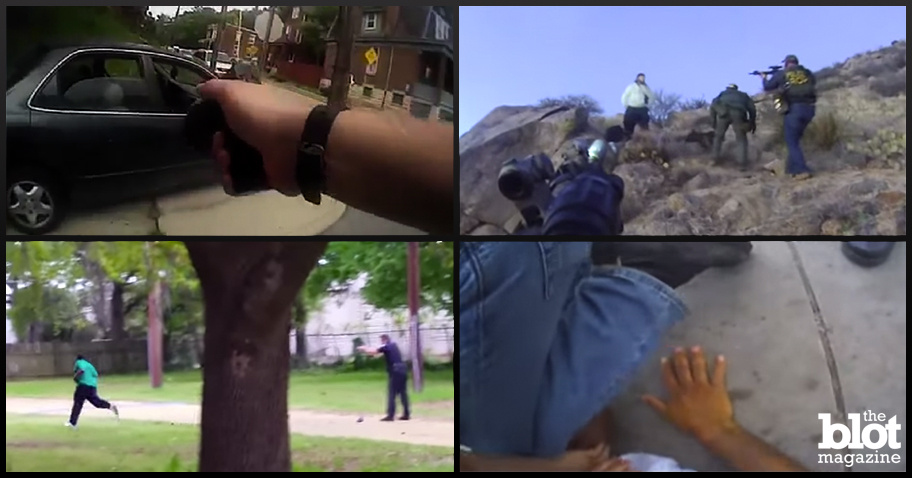Charges brought earlier this week against a white Ohio police officer who fatally shot an unarmed black man during an encounter in mid-July might never had been brought had it not been for a video camera mounted to the officer’s chest.
The video, which runs nearly a half-hour in length, was released by a county prosecutor Wednesday after a grand jury indicted former University of Cincinnati Officer Ray Tensing, 25, for the shooting death of 43-year-old Samuel Dubose during a traffic stop July 19.
In the tape filmed by Tensing’s body camera, both men can be seen discussing whether Dubose owned the vehicle he was stopped in and if the man had a driver’s license on him. Dubose tells the officer he isn’t sure if he has his license with him, but assures Tensing that if he runs his name in the computer a valid one will pop up.
Tensing, unconvinced, asks Dubose to step out of the car. The officer reaches into the man’s car after Dubose turns on the ignition. Tensing files a single shot, and Dubose’s car takes off. It crashes into a utility pole less than a half block away; seconds later, Tensing approaches the car with his handgun drawn. Dubose’s lifeless body is seen slumped over the passenger side seat, blood pouring from a head wound and splattered on the wall of the sedan.
“It was a senseless, asinine shooting,” Joseph Deters, the Hamilton County prosecutor bringing the case against Tensing, said at a press briefing Wednesday. “People don’t get shot for a traffic stop.”
Less than two minutes elapses between the traffic stop, which was apparently over the lack of a front license plate, and the shooting. Later on in the video, Tensing tells other officers on scene that Dubose tried to drag him with his vehicle. The video, which is pixelated in parts, doesn’t make it obvious whether Dubose’s car caught Tensing’s arm and dragged him — but if it did, it would have been mere inches and for less than a second before the shot was fired.
“This office has probably reviewed 100 police shootings, and this is the first time we’ve thought, ‘This is without question a murder,'” Deters said.
Tensing now faces life in prison if convicted of the murder charge. Activists who have followed the story for weeks say if it wasn’t for the video evidence, it would have been an officer’s word against a dead man’s.
Video Playing Big Role in Officer-Involved Shootings
This year alone, video has been credited with helping prosecutors bring charges against cops in at least three high-profile cases.
In January, two Albuquerque police officers were charged over the fatal shooting of a homeless man that was filmed by a body camera. Three months later, video recorded via an officer’s sunglasses led to manslaughter charges against a 73-year-old reserve deputy who fatally shot 44-year-old Eric Harris at the end of a foot pursuit in Oklahoma. And in May, a cellphone video captured by an eyewitness convinced prosecutors in South Carolina to charge Michael Slager for fatally shooting 50-year-old Walter Scott as he fled from the police officer at the end of a traffic stop.
Although none of the officers mentioned have not yet faced trial, the videos have convicted all of them in the court of public opinion: In all of the videos, the suspects posed little — if any — threat to the officers involved. In all of the videos, the officers could have — and many have argued, should have — used less-lethal force. In all of the videos, the victims were killed by bullets.
It is a sharp contrast to cases involving officers fatally shooting suspects for which there is no video evidence. Last year’s killing of an unarmed black teenager by a white police officer in Ferguson, Mo., drew a sharp divide between supporters and critics of police over whether the shooting was justified. The debate was intensified over the lack of video evidence in the incident.
Read more: Ferguson Police Chief Lied About Michael Brown Surveillance Tape
The tension from the case led to several nights of violent protests in the St. Louis suburb escalated by the police chief’s decision to publicly stand by Darren Wilson, the officer who fatally shot 18-year-old Michael Brown Jr. A grand jury later decided not to criminally charge Wilson.
Surveillance cameras have been used by police and other law enforcement agents for years, with the most-ubiquitous being car-mounted dashboard cameras that mainly record traffic encounters. Prior to Ferguson, body cameras were worn by some police officers working in larger cities; after Ferguson, many other agencies began looking to equip their officers with the cameras. The federal government has earmarked more than $260 million to help police buy them.
The working theory is that body cameras will help settle disputes in cases involving police officers and civilians. But recent data has also shown that body cameras have another effect: Officers who wear them are less likely to use force during encounters with suspects.
Read more: NYPD to Be Armed with Cameras, But Will It Cuff Them in the End?
In Northern California, reports of use of force dropped as much as 30 percent after officers in several San Francisco and Silicon Valley suburbs began wearing the cameras. In Oakland, where more than 700 police officers wear the cameras, use of force incidents dropped more than 70 percent since body cameras became available to the agency in 2010.
Surveilling the Surveillers
Law enforcement officials have become optimistic about the increased use of video surveillance in encounters with civilians in part because the videos can help back or dispute different versions of events. In a small handful of cases, police have even released videos to help quash rumors circulating on the Internet.
Such was the case last week when officials in Waller County, Texas, released hours of jailhouse surveillance video showing police interacting with Sandra Bland, a 28-year-old woman who was taken into custody following a controversial traffic stop earlier this month.
Bland’s case received immense attention from activists after she was found dead in her jail cell three days after her arrest. Her death, ruled a suicide by county officials, had been the center of controversy by activists who believe the woman was murdered while in police custody. Some even claimed that a mugshot photo of Bland had been taken by jail staff after her death, and that the image had been manipulated to make it appear as if the woman was alive.
Read more: Sheriff at Center of Sandra Bland Case Has Past Charges of Racism
The speculation and rumors fueled by activists and conspiracy theorists on social media triggered death threats against jail staff and the officer who arrested Bland. Those threats provoked county officials to release hours of surveillance video from the jail in an effort to dispel those rumors.
The videos, hours of which were released to the press, showed Bland making telephone calls, going through the routine booking process and taking her mugshot — very much alive at all times. Although some critics opined that the videos might have been doctored, speculation as to what happened to Bland prior to her death mostly quelled after the release of the footage.
But the footage did little to stem the anger of those seeking criminal charges against the officer who arrested Bland. Other video released prior to the jailhouse footage revealed the state trooper who stopped Bland on July 13, 30-year-old Brian Encinia, threatened to use a taser against Bland after the woman refused to step out of her vehicle.
Moments before, Bland had been verbally combative, complaining at length for being stopped over a alleged failure to signal while changing lanes. When she refused to step out of her vehicle, Encinia pointed his taser at Bland and shouted, “I will light you up.”
Glenn Smith, the sheriff of Waller County who is investigating the stop and Bland’s death, said the hour-long video of Bland’s arrest and the hours-long surveillance video released this week would help him determine whether any would be disciplined or fired in the case.
“There will be some action taken in the future,” Smith said.
Matthew Keys is a contributing journalist for TheBlot Magazine.






